Juror’s Award “light” : a conversation with Margaret Albaugh
Margaret Albaugh is a Chinese-American documentary and fine art photographer based in the Pacific Northwest. Margaret was the Juror’s selection from our exhibition “Light.”
Albaugh also studies psychology and that interest can be seen infused into her work. Her interest in human nature, identity and social constructs inform her personal projects. She aims to pay homage to the complicated nature of being human and escaping the comfort of duality. Much of her work includes her children and her development and musings as a mother often inspire her work.
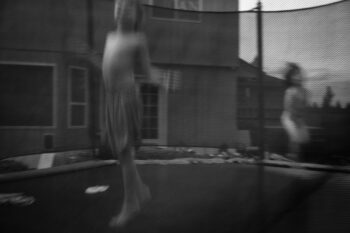
Kevin: Hi Margaret, your Images look wonderful in the gallery. Thank you for allowing us to live with them for a bit. Having grown-up the only boy in a family with three sisters, it is like a walk down memory lane, with all the imagery of young girls at play — we had a swimming pool, a trampoline and a piano.
Feral is an interesting word — It can have various connotations. I had a friend years ago that was half Filipino. He was a poet and he intimated that he felt, and others did too, there was something wild, different (feral) about him as a person from a different land, the East. Yet he spoke Spanish and had an English last name.
After reading your various artist statements I get the feeling that using “Feral” as the title of your exhibition it appears that it may apply to you in some way, as well as to childhood and your children moving through it?
Margaret: As for “Feral”, as an artist in photography I have realized how little families take center stage in art. And when I think of my favorite fine art photographers whose work looks at family life, I think of Sally Mann and Alain LaBoile. Their work is gorgeous and they have both inspired me for years. For a long time though, I felt like I couldn’t create beautiful or meaningful work because it didn’t look like theirs – the setting is different, the children look different. These artists live in idyllic landscapes that would be impossible for me – I live in a rather typical suburban real estate development. But as I photographed my children, I realized that the idyllic landscape is in their imagination. And being feral is more about how free they are to explore their imaginations and less about the landscapes in which they play.
I do recognize also that my children don’t look like a lot of the children I have seen in fine art family work. And I think that was more of an inspiration to keep creating work so that there’s more representation.
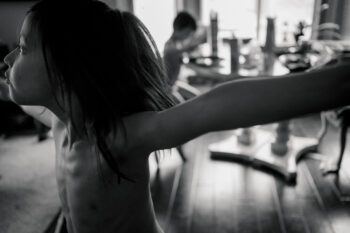
Kevin: “But as I photographed my children, I realized that the idyllic landscape is in their imagination. And being feral is more about how free they are to explore their imaginations and less about the landscapes in which they play.”
I read the above and thought, yes indeed, that is also the definition of what many of us artists do in our studios, typically physically removed from so much of what we attempt to represent, actually and metaphysically. In your images we don’t know precisely where your children are playing, so we can place them in our memories of play.
I am generally consciously or subconsciously aware of the evocative nature of the art I am creating as I’m creating it. This way of moving creatively places me obliquely in the work, whether I am aware of it or not. Does this resonate with you?
Margaret: I think with my work, especially with fine art family work, I try to frame the composition in a way that removes any distracting specificity. By that I mean, I try to be cognizant of things in the frame that might be indicators of a really specific time frame – logos, movie references, children’s show characters. Depending on the work, I find that these details affect how one interacts with the work and how they connect with it. For the most part, I try to evoke a timelessness.
When I’m doing work that is more photojournalistic in style, I find those details necessary for understanding the specific people and time frame. But for this work about childhood, family, nostalgia, I’m aware that those details bring people into a cognitive space and prevent one from projecting their own experiences when engaging with the work.
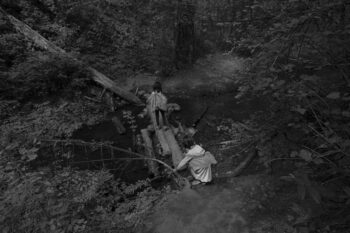
Kevin: Margaret, a question I have wanted to ask a photographer that exists in both worlds, commercial and fine art, — Do any of your commercial clients that view your fine art work connect with it and request something similar for their projects? I think this question is about “style,” which many chafe at the mention of, but I feel is an important aspect of the photographic journey.
Margaret: I don’t think anyone has directly asked. I have a section of my website just for documentary family clients and the work there is fairly representative of what I do for families. I think the difference is more of an inclination towards humor with my family work. But I do try and weave in a more “fine art” approach when the opportunity presents itself. So, in the end my commercial family work may include a spectrum of what can be thought of as documentary – a photojournalistic approach to a fine art style.
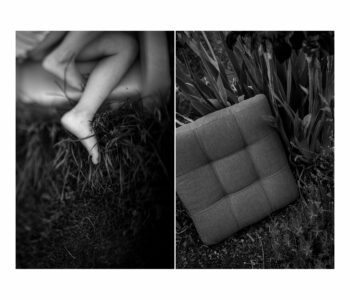
Kevin: One last question. You have three images in the group you have up in the gallery that reference flying — your daughters with their arms outstretched, as if they are ready to take off. Are those also autobiographical images?
Thanks so much for taking the time to visit with us and all the best with your photographic journey!
Margaret: I think there’s some projection there with the wings. But I also think it’s part of our environment and life. We’re an Air Force family and when my oldest was a toddler, we lived right by base. She would run around with her “wings” outstretched all the time. Maybe she would’ve done that regardless of my spouse’s occupation but it was something I always noticed. Also, I think it’s just a beautiful allegory for childhood – to grow, to try out your wings, to find ways to take off, to not be burdened. I think I project a little of my own desires there – a desire to her unburdened, to feel I can spread my wings and explore all the time. To feel a sense of weightlessness…. I think it helps me remember childhood.
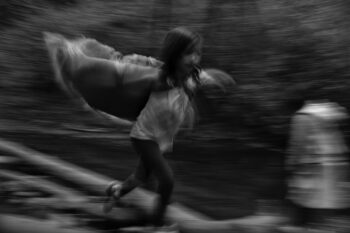
To see more of Margaret’s work follow this link.
